Analysis of the Radon Concentration in Selected Rooms of Buildings in Poznan County
Abstract
:1. Introduction
2. Materials and Methods
2.1. Site
2.2. Measuring Devices
2.3. Time of Measurements
2.4. Methods
3. Research Results
3.1. Average Radon Concentration
- For building B, for room B1, the highest value of the average radon concentration was obtained at the concentration level of 130 ± 32 Bqm−3, at the median of 126 Bqm−3. For room B2, the mean value was obtained, respectively, as 93 ± 23 Bqm−3 and a median of 95 Bqm−3.
- In building C in December, the average concentration was 59 ± 15 Bqm−3 and 67 ± 17 Bqm−3, respectively for rooms C2 and C1. In February, the recorded average radon concentration was 50% lower than in December. For the entire measurement period for the C1 rooms, the mean value was obtained at the level of 40 ± 10 Bqm−3 and median of 31 Bqm−3, and for room C2 45 ± 11 Bqm−3, the median was 32 Bqm−3.
- The lowest radon concentration was recorded in a building with an operating supply and exhaust ventilation with a controlled concentration of carbon dioxide in the room. The average concentration recorded in building A was at the level of 31 ± 8 Bqm−3 and a median of 21 Bqm−3.
- The monthly variability of the radon concentration was observed.
3.2. Concentrations of Indoor Air Quality Parameters
3.3. Variation in Time of the Radon Concentration Profile
3.4. Correlations of Radon Concentration with Other Measured Parameters
3.5. Variation in Time of the Radon Concentration Profile
3.5.1. Rooms B1 and B2
3.5.2. Building B Outdoor Environment
3.6. Influence of Users on the Concentration of Radon in the Room
4. Discussion
5. Conclusions
Author Contributions
Funding
Institutional Review Board Statement
Informed Consent Statement
Acknowledgments
Conflicts of Interest
References
- Curado, A.; Lopes, I.S. On the relation of geology, natural ventilation and indoor radon concentration: The northern Portugal case study. Antão Comun. Geológicas 2020, 107, 31–41. [Google Scholar] [CrossRef]
- Kubiak, A.K.; Zimnoch, M. Assessment of the nocturnal boundary layer height based on long-term atmospheric radon measurements. Front. Earth Sci. 2022, 10, 955791. [Google Scholar] [CrossRef]
- World Health Organization. WHO Housing and Health Guidelines; World Health Organization: Geneva, Switzerland, 2018. [Google Scholar]
- Kang, J.K.; Seo, S.; Jin, Y.W. Health effects of radon exposure. Yonsei Med. J. 2019, 60, 597–603. [Google Scholar] [CrossRef] [PubMed]
- Mamont-Cieśla, K. Radon—Promieniotwórczy Gaz w Środowisku Człowieka, Centralne Laboratorium Ochrony Radiologicznej. Available online: https://www.clor.waw.pl/images/pliki/Pomiar_Radonu/Radon-1a_Kalina_radon.pdf (accessed on 22 March 2022).
- Arvela, H. Seasonal variation in radon concentration of 3000 dwelling with model comparison. Radiat. Prot. Dosim. 1995, 59, 33–42. [Google Scholar]
- Rubin, A.J. Radon exhalation from buildings material. In Proceedings of the XVII Szkoła Jesienna PTBR—Radon-występowanie i konsekwencje—Zakopane’97, Siedlce, Poland, 22–26 September 1997. [Google Scholar]
- Gorączko, W. Podstawy ochrony radiologicznej. In Radiochemia i Ochrona Radiologiczna; Wydaw; Politechniki Poznańskiej: Poznań, Poland, 2003; Volume 3, pp. 65–130. [Google Scholar]
- Abbott, A. Researchers pin down risks of low-dose radiation. Nature 2015, 523, 17–18. [Google Scholar] [CrossRef]
- Yasser, F.A.; Cucinotta, F.A.; Ning-Ang, L.; Zhou, G. Cancer Risk of Low Dose Ionizing Radiation. Front. Phys. 2020, 100, 13761–13766. [Google Scholar] [CrossRef]
- World Health Organization. WHO Handbook on Indoor Radon a Public Health Perspective; World Health Organization: Geneva, Switzerland, 2009. [Google Scholar]
- Branion-Calles, M.C.; Nelson, T.A.; Henderson, S.B. Evaluation of different radon guideline values based on characterization of ecological risk and visualization of lung cancer mortality trends in British Columbia, Canada. BMC Public Health 2015, 15, 1144. [Google Scholar] [CrossRef] [PubMed]
- Korzeniowska-Rejmer, E. Radon w Gruncie i Techniki Redukcji Jego Stężenia w Obiektach Budowlanych; Wydawnictwo Politechniki Krakowskiej: Kraków, Poland, 2008. [Google Scholar]
- Istrate, M.-A.; Catalina, T.; Cucosb, A.; Dicu, T. Experimental measurements of VOC and Radon in two Romanian classrooms. Energy Procedia 2016, 85, 288–294. [Google Scholar] [CrossRef] [Green Version]
- Maroni, M. Health Effects of Indoor Air Pollutants and their Mitigation and Control. Radiat. Prot. Dosim. 1998, 78, 27–32. [Google Scholar] [CrossRef]
- Geological Maps. Available online: https://geolog.pgi.gov.pl/#name=3tjqgffirm (accessed on 5 October 2022).
- Manufacturer of Meters. Available online: https://www.instrumentchoice.com.au/mini-xt-radon (accessed on 3 April 2022).
- Data Page. Available online: https://syngeos.pl/ (accessed on 3 April 2022).
- Dolny, E.; Sienkiewicz, K. Podstawy Statystyki; Toruńska Szkoła Zarządzania: Toruń, Polska, 2000; Volume 4, pp. 113–164. [Google Scholar]
- R Core Team. R, A Language and Environment for Statistical Computing; R Foundation for Statistical Computing: Vienna, Austria, 2018; Available online: https://www.R-project.org/ (accessed on 22 March 2022).
- Basińska, M.; Michałkiewicz, M.; Ratajczak, K.; Fuc, P.; Siedlecki, M. The Way of Usage and Location in a Big City Agglomeration as Impact Factors of the Nurseries. Energies 2021, 14, 7534. [Google Scholar] [CrossRef]
- Kozak, K.; Mazur, J.; Kochowska, E.; Grządziel, D.; Hovhannisyan, H.; Haber, R.; Zdziarski, T. Pomiary Radonu w Budynkach na Terenie Kotliny Jeleniogórskiej w Ramach Projektu UE pt. “Radon-Jak z Nim Żyć?”; Raport Nr 2017/AP; Instytut Fizyki Jądrowej: Kraków, Poland, 2008. [Google Scholar]
- Pachocki, K.A.; Gorzkowski, B.; Różycki, Z.; Wilejczyk, E.; Smoter, J. Radon w budynkach mieszkalnych Świeradowa zdroju i Czerniawy Zdroju (Radon in residential buildings in Świeradów Zdrój and Czerniawa Zdrój). Rocz. Państwowego Zakładu Hig. 2000, 51, 291–298. [Google Scholar]
- Mullerova, M.; Kozak, K.; Kovacs, T.; Csordas, A.; Grzadziel, D.; Holy, K.; Mazur, J.; Moravcsik, A.; Neznal, M.; Neznal, M.; et al. Preliminary results of indoor radon survey in v4 countries. Radiat. Prot. Dosim. 2014, 160, 210–213. [Google Scholar] [CrossRef] [PubMed]
- Xie, D.; Liao, M.; Kearfott, K.J. Influence of Environmental Factors on Indoor Radon Concentration Levels in the Basement and Ground Floor of a Building—A Case Study. Radiat. Meas. 2015, 82, 52–58. [Google Scholar] [CrossRef] [Green Version]
- Polednik, B.; Kozak, K.; Mazur, J.; Dudzin, M.; Grządziel, D. Radon and its decay products in an air-conditioned auditorium in correlation with indoor air parameters. Indoor Built Environ. 2016, 26, 621–630. [Google Scholar] [CrossRef]
- Basińska, M.; Michałkiewicz, M.; Ratajczak, K. Impact of physical and microbiological parameters on proper indoor air quality in nursery. Environ. Int. 2019, 132, 105098. [Google Scholar] [CrossRef]
- Podstawczyńska, A. Interrelationship of Indoor Radon Concentration and Meteorological Parameters in Łódź (Central Poland) Case Study—Preliminary Results; University of Lodz: Łódź, Poland, 2015. [Google Scholar]
- Podstawczyńska, A. Wyniki rocznego monitoringu stężenia radonu w powietrzu budynku mieszkalnego w Łodzi na tle warunków meteorologicznych. Acta Geogr. Lodz. 2016, 104, 137–146. [Google Scholar]
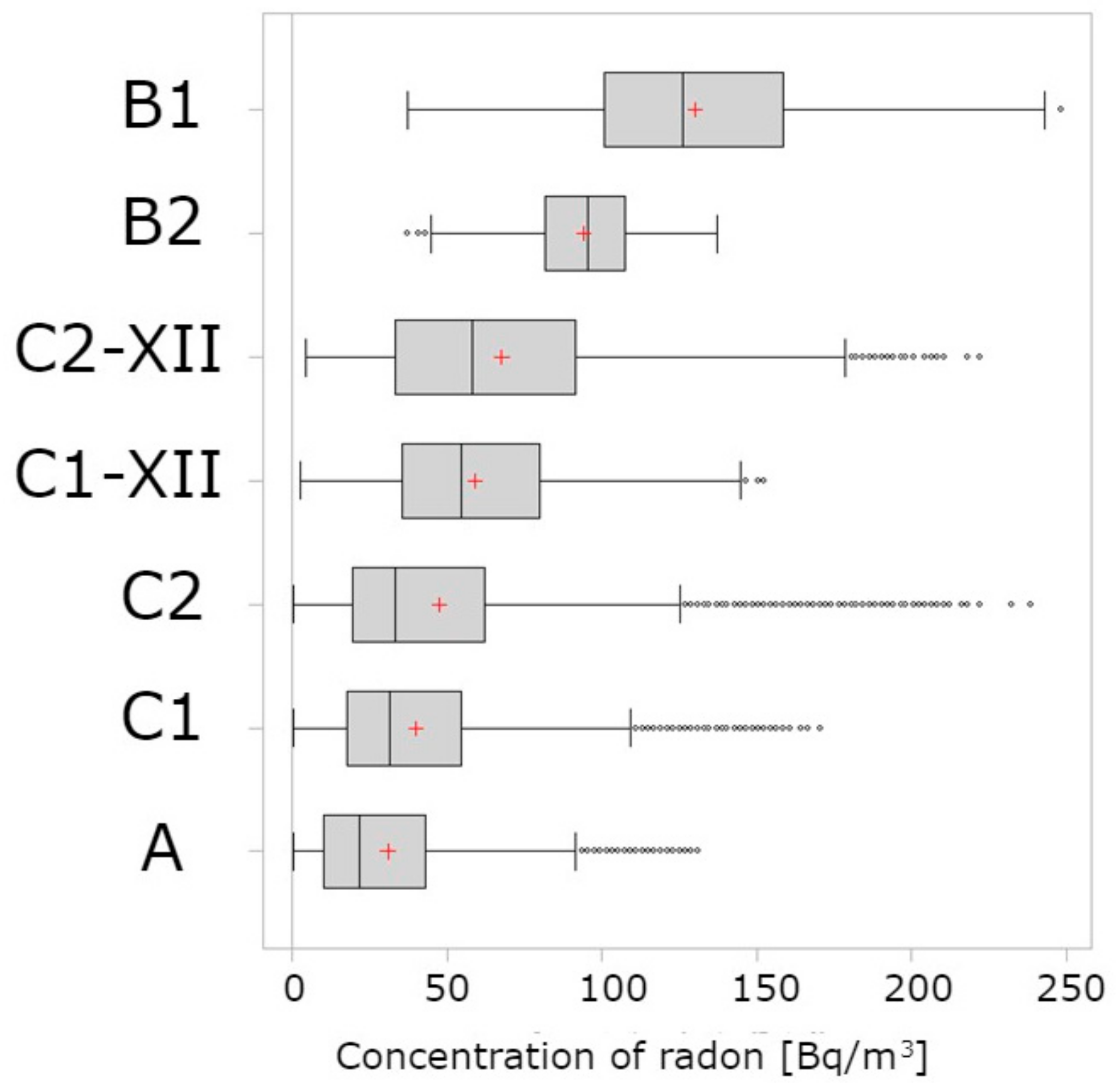

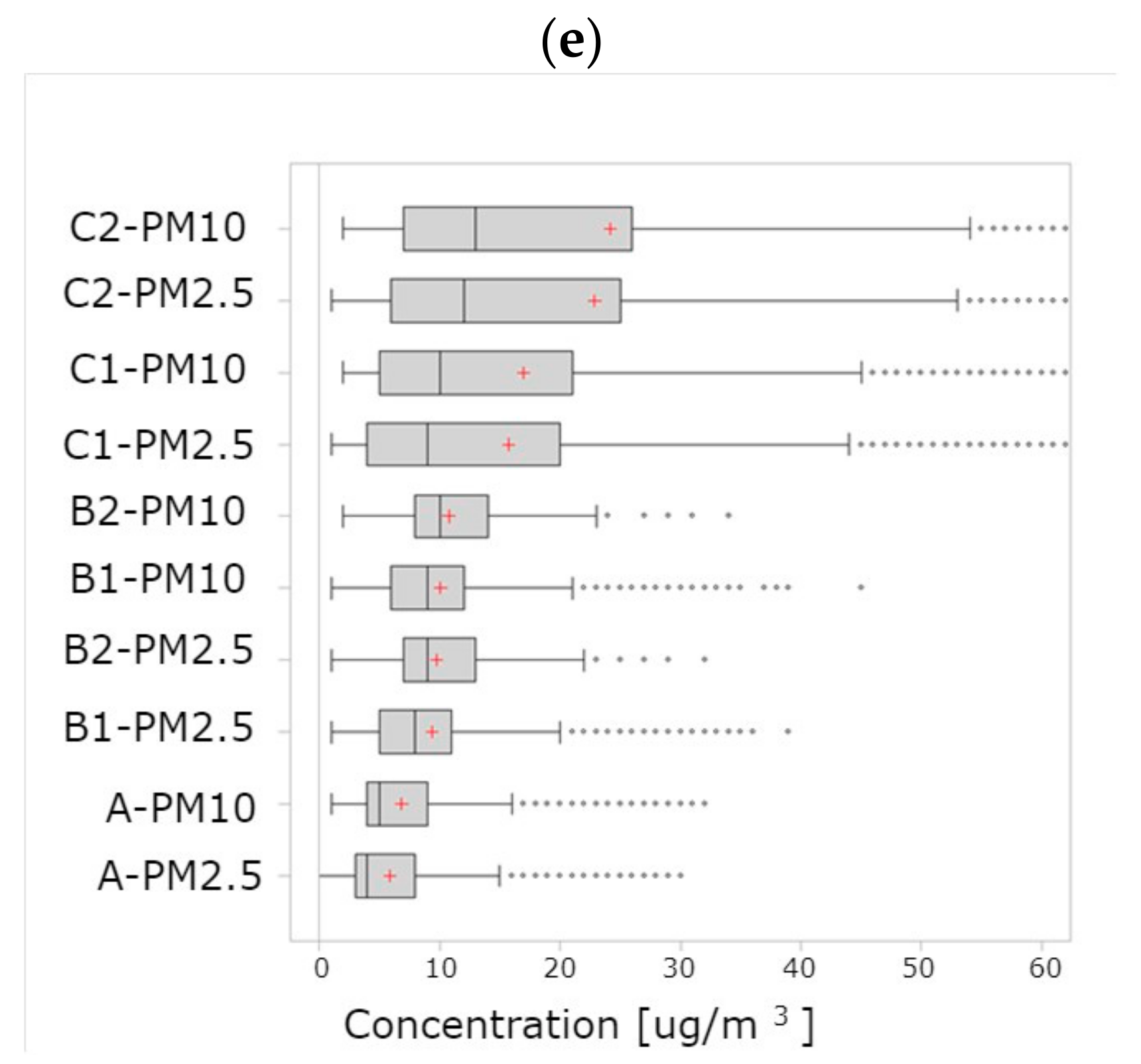
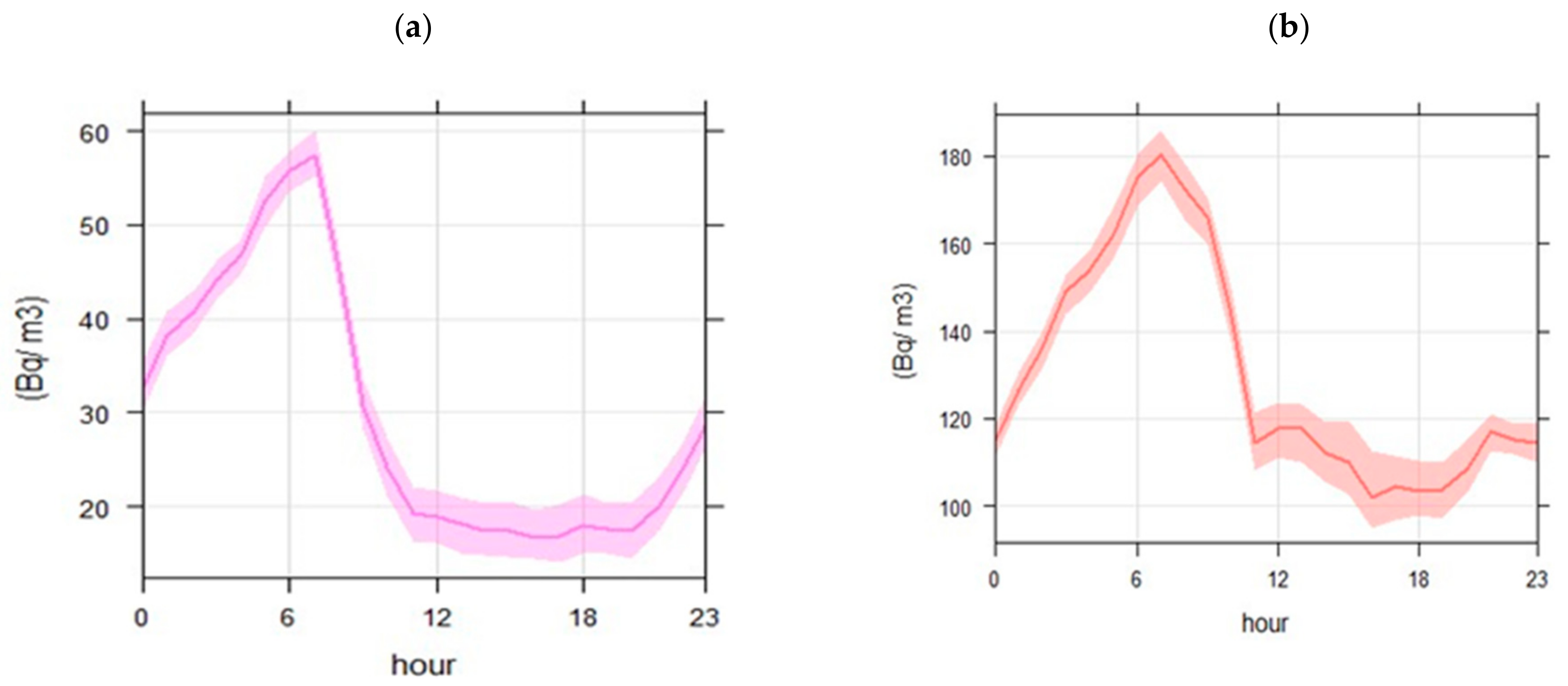
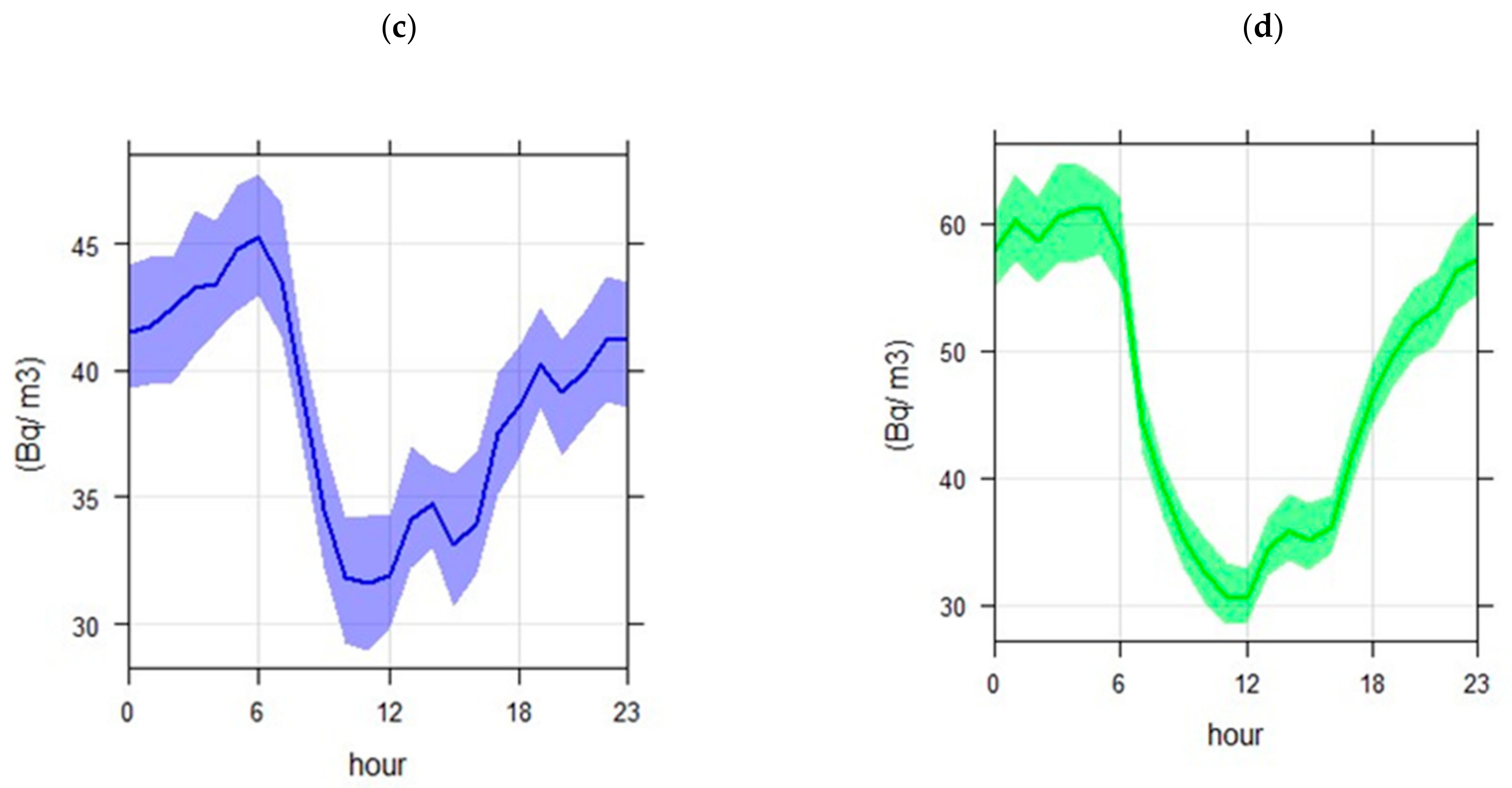

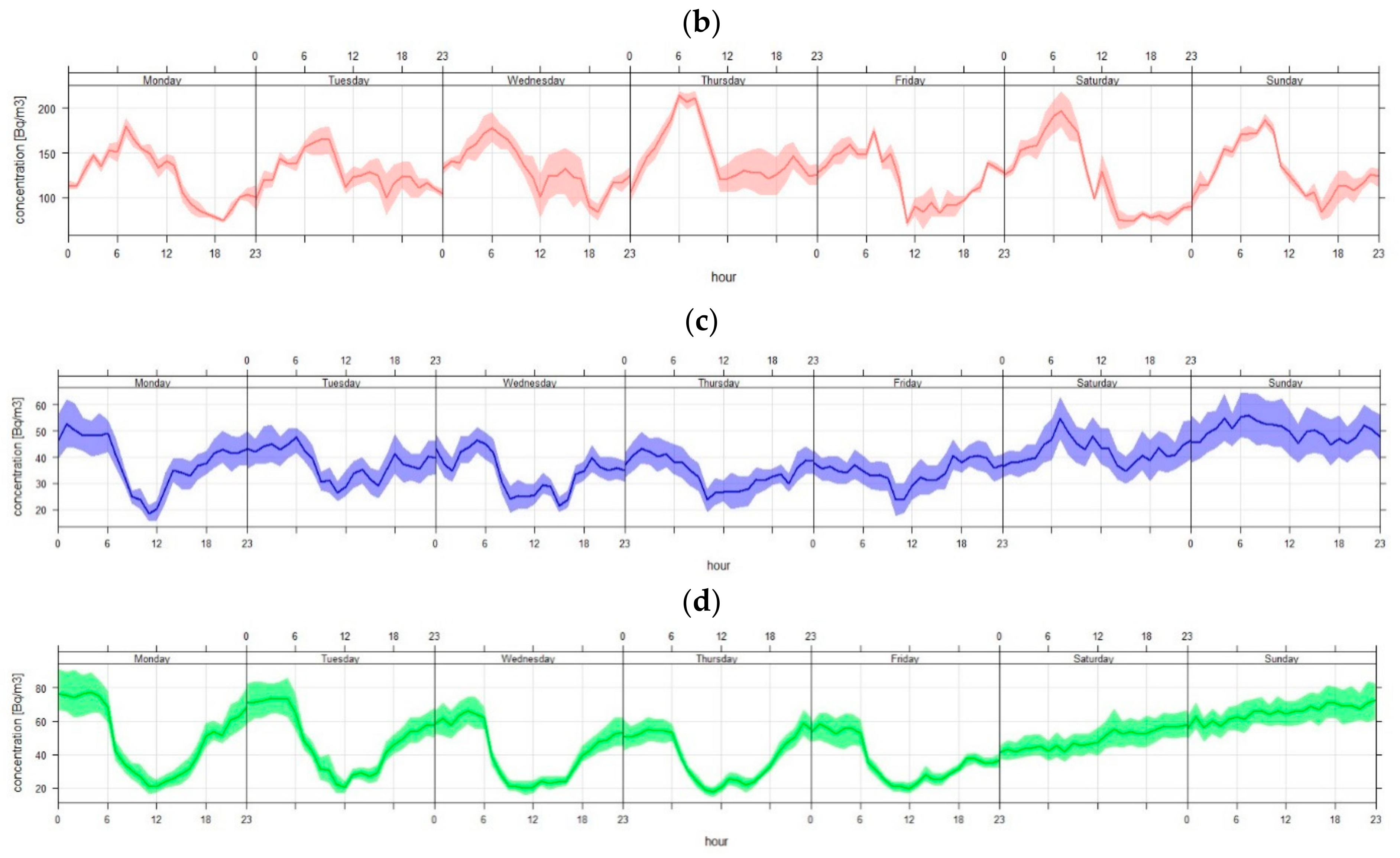
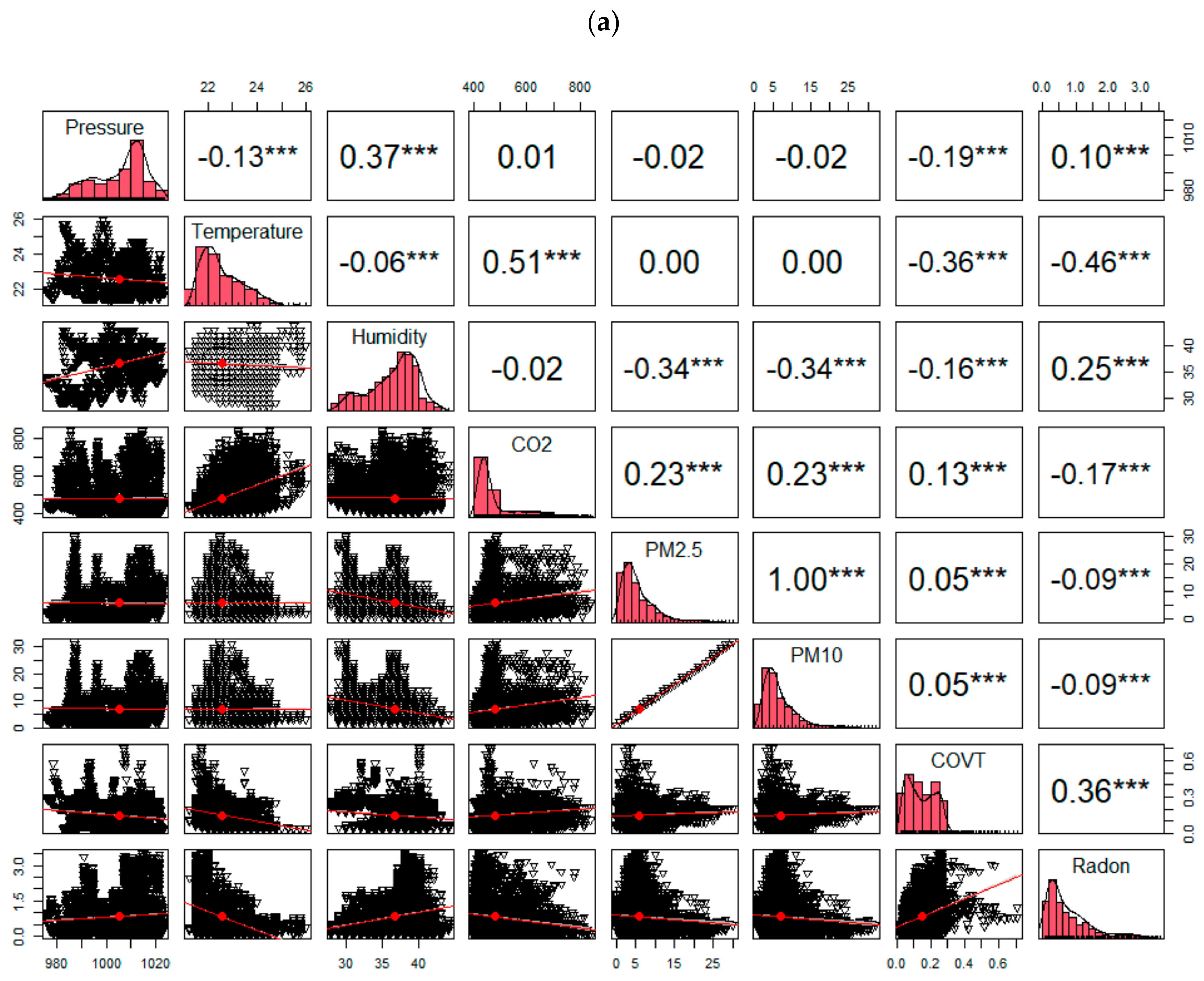

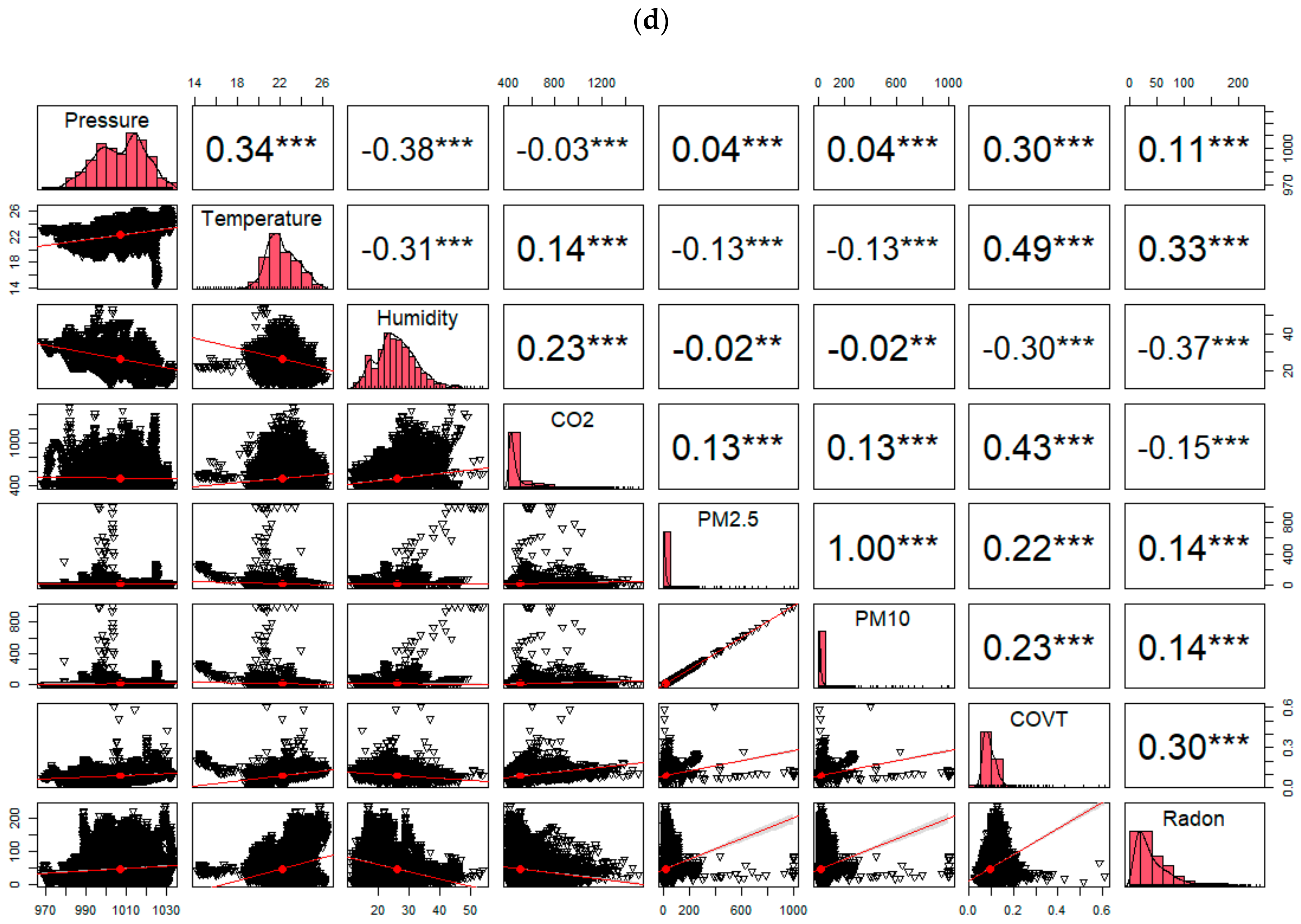
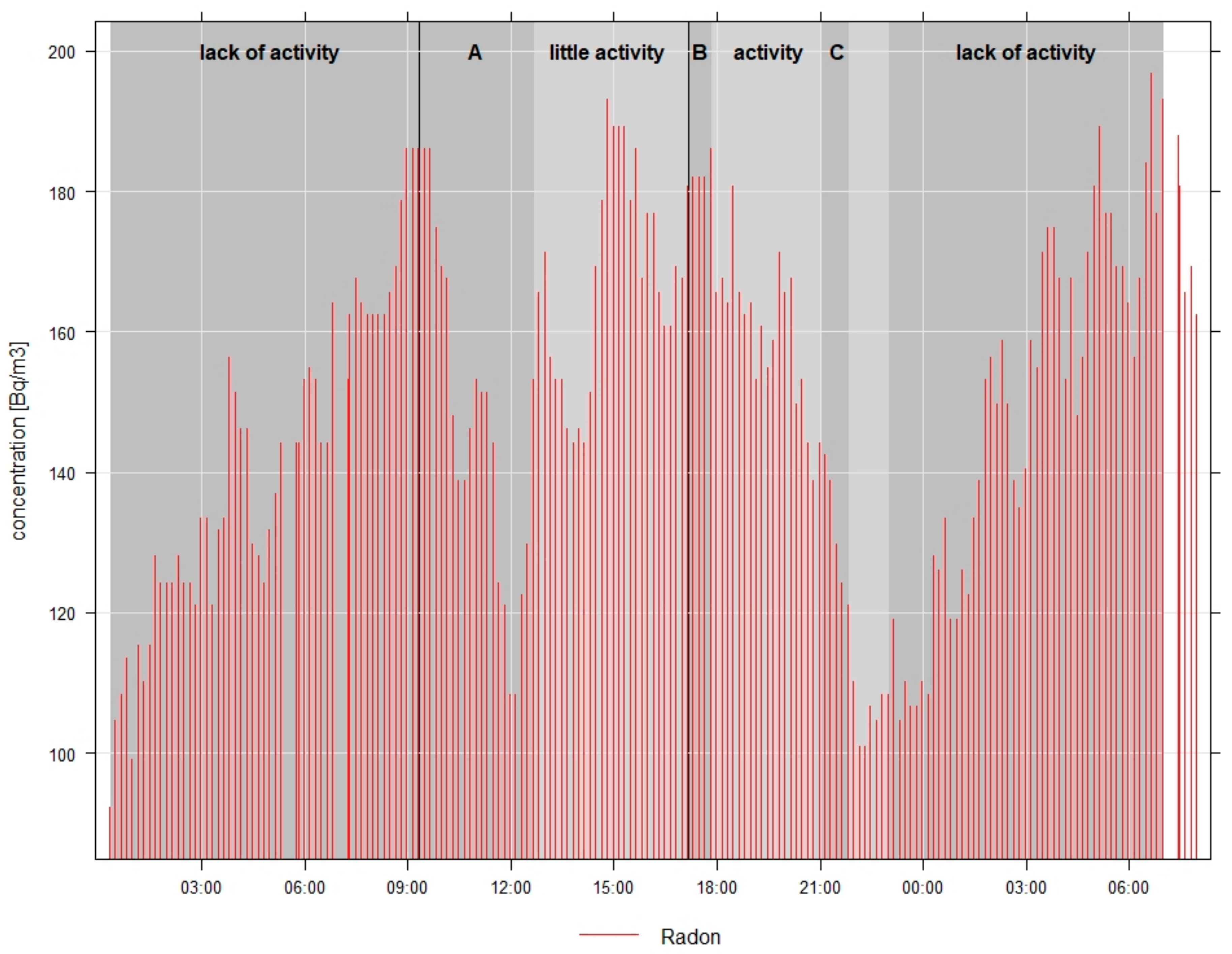
| Source | Percentage Share |
|---|---|
| Substrate as a result of diffusion | 3 |
| Substrate as a result of chimney effect | 75 |
| Building materials | 12 |
| Atmospheric air | 9 |
| Weather | 0.4 |
| Natural gas | 0.6 |
| Room | Location | Area [m2] | Height [m] | Deep Mapping | Quaternary | Additional Information |
|---|---|---|---|---|---|---|
| A | 2st floor | 26.3 | 3.0 | Upper Jurassic | glacial till their weathered material, and glacial sand and gravel; North Polish glaciations | urbanized area |
| B1 | Ground floor | 12.0 | 2.8 | Lower Jurassic | faults within a 2 km radius, rural area | |
| B2 | Ground floor | 8.0 | 2.8 | |||
| C1 | Ground floor | 53.6 | 3.6 | Upper Jurassic | sands, gravel, river bogs, peat and silt; Holocene | urbanized area |
| C2 | Ground floor | 53.6 | 3.6 |
| Measurement | Detection Method | Measuring Range | Resolution | Accuracy |
|---|---|---|---|---|
| Radon | Pulsed ionization chamber | 4–3700 Bqm−3 | 2 Bqm−3 | 10% of reading value at 370 Bqm−3 40% of reading value lower than 370 Bqm−3 25% for the average of the measurements for the measurements below 370 Bqm−3 |
| Carbon dioxide | Non Dispersive Infrared spectrometry | 0–5000 ppm | 1 ppm | 3% of reading value at 50 ppm |
| Dust | Laser-based light scattering that allows PM 1/2.5 measurement and PM 4/10 estimation | 0–1000 ugm−3 | 1 ugm−3 | 10% of reading value |
| TVOC | Metal oxide semi-conductor | 0–128 ppm | 0.01 ppm | 30% of reading value |
| Temperature | Temperature detector on circuits CMOS | −55–125 °C | 0.08 °C | 0.5 °C |
| Humidity | Capacitive moisture meter | 0–95% | 0.08% | 3% of reading value |
| Pressure | Temperature detector on circuits CMOS | 260–1260 hPa | 0.02 hPa | 2 hPa |
| Building | Room | Beginning | End |
|---|---|---|---|
| A | A | 15 October 2021 | 2 December 2021 |
| B | B1 | 8 March 2022 | 25 March 2022 |
| B2 | 10 March 2022 | 15 March 2022 | |
| C | C1 | 4 December 2021 | 10 March 2022 |
| C2 | 4 December 2021 | 26 March 2022 | |
| C1-XII | 4 December 2021 | 31 December 2021 | |
| C2-XII | 4 December 2021 | 31 December 2021 |
| Value rxy | Interpretation |
|---|---|
| rxy = 0 | no lineral correlation |
| rxy = 1 | full correlation |
| rxy < 0 | negative correlation |
| rxy > 0 | positive correlation |
| rxy < 0.2 | very weak correlation |
| 0.2 < rxy < 0.4 | correlation weak, but clear |
| 0.4 < rxy < 0.7 | significant correlation |
| 0.7 < rxy < 0.9 | strong correlation |
| 0.9 < rxy | very strong correlation |
| p-Value | Expression Mark |
|---|---|
| [0, 0.001] | *** |
| (0.001, 0,01] | ** |
| (0.01, 0.05] | * |
| (0.05, 0.1] | . |
| (0.1, 1] | lack |
| Room | Maximum | Minimum |
|---|---|---|
| A | 7:00–8:00 | 15:00–16:00 |
| B1 | 8:00 | 16:00–18:00 |
| C1 | 5:00–6:00 | 11:00–12:00 |
| C2 | 4:00–5:00 | 11:00–12:00 |
| Pressure | Temperature | Humidity | TVOC | PM2.5 | PM10 | Radon |
|---|---|---|---|---|---|---|
| 1 | −0.054 | −0.079 | 0.025 | 0.59 | 0.57 | 0.34 |
| p < 0.001 | p < 0.001 | p < 0.1 | p < 0.025 | p < 0.001 | p < 0.001 | p < 0.001 |
| PM2.5 | PM10 |
|---|---|
| 0.60 | 0.61 |
| p < 0.1 | p < 0.1 |
Publisher’s Note: MDPI stays neutral with regard to jurisdictional claims in published maps and institutional affiliations. |
© 2022 by the authors. Licensee MDPI, Basel, Switzerland. This article is an open access article distributed under the terms and conditions of the Creative Commons Attribution (CC BY) license (https://creativecommons.org/licenses/by/4.0/).
Share and Cite
Kubiak, J.A.; Basińska, M. Analysis of the Radon Concentration in Selected Rooms of Buildings in Poznan County. Atmosphere 2022, 13, 1664. https://doi.org/10.3390/atmos13101664
Kubiak JA, Basińska M. Analysis of the Radon Concentration in Selected Rooms of Buildings in Poznan County. Atmosphere. 2022; 13(10):1664. https://doi.org/10.3390/atmos13101664
Chicago/Turabian StyleKubiak, Joanna Aleksandra, and Małgorzata Basińska. 2022. "Analysis of the Radon Concentration in Selected Rooms of Buildings in Poznan County" Atmosphere 13, no. 10: 1664. https://doi.org/10.3390/atmos13101664
APA StyleKubiak, J. A., & Basińska, M. (2022). Analysis of the Radon Concentration in Selected Rooms of Buildings in Poznan County. Atmosphere, 13(10), 1664. https://doi.org/10.3390/atmos13101664







